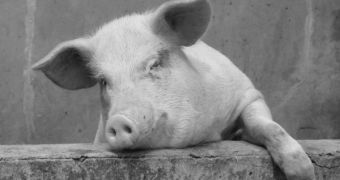A new scientific study evidenced the fact that the average farm pig could learn to find food with the help of mirror reflections in less than five hours. As this ability pigs had had been proven, experts added it to the small number of species who could recognize themselves in the mirror, which included dolphins, some primates, elephants and magpies. All these animals were either able to observe themselves in the mirror, or to remove marks from themselves, if they saw their reflection. In the experiments, seven out of eight pigs were able to learn how to use a mirror to find a bowl of food.
“This is the first demonstration of the ability of pigs to use mirrors. Finding sophisticated learning and awareness in animals can alter the way that people think about the species and may result in better welfare in the long run,” University of Cambridge animal behavior expert Donald Broom told Wired in an email. He is also a co-author of a new scientific paper detailing the find, published in this month's issue of the respected scientific journal Animal Behavior.
According to the scientist, the pigs were very curious at first, when the shiny mirror was introduced in their pens. They inspected the object extensively, and then looked to see what was behind it. After that, they spent about 20 minutes on average looking at their own reflection, constantly changing angles to get a better view of themselves.
“These kind[s] of movements suggest that the pigs were correlating the movements of their body with the visual stimulus they were receiving from the mirror, and so learning the contingency between the two,” biologist Louise Barrett, from the University of Liverpool, in the UK, explained in a commentary accompanying the paper.
“These results suggest not only that pigs learn the contingency between their own movements and their image in the mirror, but that their knowledge incorporates the layout of the environment as well, so that they can locate objects in space,” she added. In experiments, pigs that had been previously exposed to mirrors were left to assess the location of a bowl of food.
Instead of searching behind the mirror, they turned around and headed for the real position of the bowl. However, nine of the eleven pigs that had not been exposed to mirrors attempted to look for the bowl in its apparent position, behind the mirror.
“Having a sense of self and using it is a form of assessment awareness. We have no conclusive evidence of a sense of self, but you might well conclude that it is likely from our results. If an animal is clever, it is less likely to be treated as if it is an object or a machine to produce food, and more likely to be considered as an individual of value in itself,” Broom concluded.

 14 DAY TRIAL //
14 DAY TRIAL //